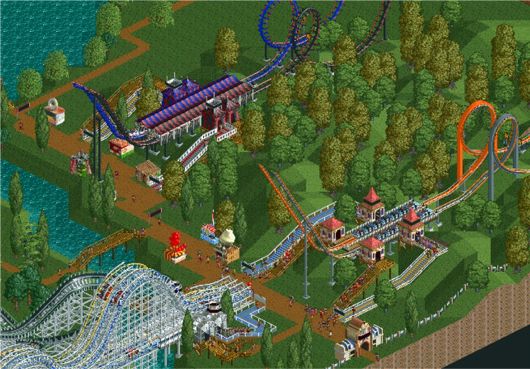The balloons go up April 2, Year 2
By Fossil
In this article, I walk through the Gravity Gardens scenario. GG has a acquired a reputation as the hardest of all the scenarios that are included with RCT2 - and for good reason!
- It is a paid admission park. It requires more technique to generate income from a paid admission park than a pay-per-ride park.
- The only rides are roller coasters - no gentle rides or thrill rides are available. Since the number of guests depends on the number of attractions, this will mean that the average cost per attraction is higher than your usual park.
- The scenario goal is a park value of $500,000. Since the value of the rides depreciates, this initially appears to be a daunting goal.
Many players fall into a trap in this scenario. After the initial build-out, they build a coaster as income permits. All the coasters depreciate. After awhile, a sort of equilibrium is reached. Each new coaster built increases park value only enough to offset the depreciation of the rest of them. The net effect is that the game can be completed with great difficulty, if at all. I've seen reports of players giving up. Clearly a better approach is needed.
The plan
Overall strategy
The overall strategy for a scenario with a park value goal is this:
- There is an initial building period - a small, profitable park is created.
- Cash is accumulated.
- Once a sufficient amount of cash is available, a massive, rapid build-out, coupled with aggressive advertising, will meet the scenario objective.
When a coaster is new, it makes its greatest contribution to park value. The coaster's value fades quickly at first, then more slowly. A new coaster's contribution to park value appears to be about four times its purchase price. So if you need to increase the park value by $300,000, then budgeting $80,000 for the build-out is reasonable (if you are careful) - consider that you will also require new stalls/shops, landscaping, scenery removal, paths, new scenery placement and advertising. Budgeting $100,000 will give you more flexibility.
Budgeting for a build-out does not mean that you need all the cash on-hand at the start of the building phase. One of the benefits of fast building, combined with advertising, is a rapid influx of new guests. In a paid admission park, this leads a jump in admissions and income. This fuels additional building, at least in the short-term.
|
Park Capacity Following are very rough estimates. I know that these metrics are not exact, but they are have been helpful to me, and are certainly better than no metrics at all. Park capacity is an equilibrium point - the number of peeps entering the park equals the number leaving. It usually takes six to eight months for capacity to be reached in a park that has no new construction. Advertising can decrease the time until capacity is reached, and can allow the park to temporarily exceed its natural capacity. Each coaster increases a park's peep capacity. The exact amount is difficult to gauge, and is probably a function of the coaster's statistics, perhaps also influenced by its size and uniqueness in the park. For a "rule-of-thumb," I use 80 peeps per coaster. An empty park has a capacity - some peeps will visit, even without attractions. This is about 50 peeps. It appears that shops and stalls also increase capacity, but to a much lesser degree. The point is that this park's capacity is greater than 80 x (number of coasters). I used this formula, then added 100 - its close enough. There is a limit to the number of park admissions per month, so building ten coasters in a month will provide a ten-coaster increase in capacity, but will not provide ten times the admission rate as compared to building one coaster. We want to keep the park admission rate as high as possible the entire game. To do this, the park capacity should always be substantially above the number of guests in the park. |
Phase I - The initial build-out
The first element in the opening strategy is the park pathing system. I made the front section double-width, and put up do-not-enter signs to cut off most of the park. Most of the wandering peeps found their way out on their own. Later, when time permitted, I assisted those that were still wandering while demolishing most of the pre-existing paths for cash. I did not build a single bench in year one.
To accumulate money as fast as possible, we need to be economical with our building.
I kept Treetop Flyer. It's inconveniently located, and sprawls too much, but I did better keeping it than demolishing it. I added an on-ride photo to it. It is a big coaster with good statistics, so it is the "Feature Attraction" in this park.
In addition to Treetop Flyer, I built six coasters - three pairs of racers.
- The standard Heartline Twister coaster "Twicky Twister"
- A small Corkscrew shuttle (including an on-ride photo)
- A small Looping shuttle (including an on-ride photo)
What these coasters have in common is that they are small and cheap. The shuttles were under $3,000 each. Twicky Twister is about $3,700. They were all built as quickly as possible. I estimated park capacity at 660 guests.
With advertising, this provided an excellent gate through the end of May.

The initial build-out. Picture taken April, Year 1